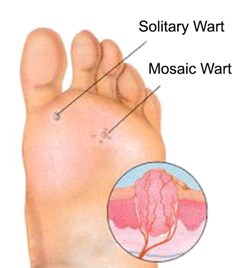Posted 26 October 2017
 Despite causing pain, itchiness and sometimes embarrassment,
warts and verrucae are not a serious condition and should clear up by
themselves for most people, although this may take years. Nevertheless, there
are treatments available if they are very bothersome or persistent. (1)
Despite causing pain, itchiness and sometimes embarrassment,
warts and verrucae are not a serious condition and should clear up by
themselves for most people, although this may take years. Nevertheless, there
are treatments available if they are very bothersome or persistent. (1)
What are warts and
verrucae?
Warts and verrucae are small lumps of keratin (a protein
produced in the body which makes up hair and nails) that can form on any part
of the body, but usually the hands and feet. They are caused by particular
strains of the human papilloma virus (HPV). The term ‘wart’ is used for these
lumps when they occur anywhere apart from the soles of the feet, where they are
called verrucae (singular: verruca) or occasionally plantar warts. (1, 2)
The common wart is usually found on the fingers, but may
affect the palms, knuckles or even knees. It protrudes from the skin, is firm
to the touch and is characterised by a rough and rugged appearance. (1)
Verrucae are found on the soles of the feet. They differ
from common warts in that they are predominantly flat from the pressure put
upon them when walking, and contain small blood vessels which are visible as
black dots. (1, 2, 3)
Plane warts are flat warts found mainly on the face, the
backs of the hands, or the shins. They are yellow in appearance. They may occur
as a single wart or in hundreds! (3)
Mosaic warts are clusters of warts or verrucae. (1)
How are warts and
verrucae treated?
The most widely available and common treatment is salicylic acid, available in forms such
as gels, plasters and skin paints. These products can be purchased over the
counter at a pharmacy. Before applying the product, it is advised to soak the
wart or verruca in water for at least five minutes to soften the skin. Then,
carefully cover the healthy skin around the wart or verruca with a layer of
petroleum jelly, as salicylic acid may damage healthy skin. After doing this,
the product can be applied. This should be done on a daily basis. The wart or
verruca can be filed with an emery board weekly to remove dead skin, but ensure
that the emery board is thrown away after use and a new one used next time. (2)
Dimethyl ether
propane is available over the counter as a spray to freeze warts and
verrucae. However, it is not as effective as using salicylic acid products. (2)
If the wart or verruca persists despite use of these
products, visit your GP who may consider treatment with liquid nitrogen. This is applied directly to the wart or verruca
and works to freeze it off. It will need to be done numerous times to
completely clear the wart or verruca up. Unfortunately, this does not always
give the desired results, in which case your GP may refer you to a
dermatologist who may look into minor surgery and other treatment options. (2)
Other reasons you will need to see your GP for warts or
verrucae include:
facial warts, which should not be treated over
the counter, as the skin on the face is very delicate and can become damaged or
scarred easily
genital warts, which are caused by different
strains of HPV to those associated with common warts and verrucae, and should
be dealt with by your GP or a sexual health clinic
recurring warts
very big or painful warts
warts that bleed or change in appearance
diabetics
pregnant women
poor circulation in the hands and feet (2)
Protecting yourself
and others from warts and verrucae
Although warts and verrucae are very contagious, there are
steps we can take to reduce the spread. Touching warts and verrucae should be
avoided, and if touched, hands should be washed as soon as possible. In
communal places such as swimming baths and changing rooms, you should cover any
verrucae you have with a verruca sock or waterproof plaster. Do not share
footwear or towels with anyone else, and ensure you keep your feet and hands
clean and dry, including a fresh pair of socks daily. (2)
If you find a lump on your skin and are in any doubt as to
what it is or you are at all concerned, your local pharmacist is there to help.
References
National Health Service. Warts and verrucas
[cited 8th September 2017]. Available from: https://www.nhs.uk/conditions/warts-and-verrucas/
NHS Choices. Warts and verrucas [cited 24 October
2017]. Available from: https://www.nhs.uk/Conditions/Warts/Pages/Introduction.aspx
Bupa. Warts and verrucas [cited 23 October
2017]. Available from: https://www.bupa.co.uk/health-information/directory/w/warts-and-verrucas
Author: Gabby Gallagher MPharm
Medically reviewed by: Superintendent pharmacist Margaret Hudson BSc(Hons)MRPharmS 26/10/17
Posted in Men's Health, Womens health